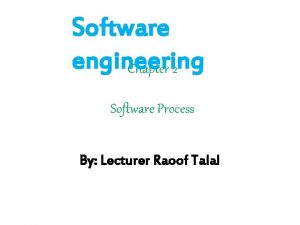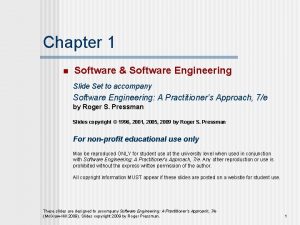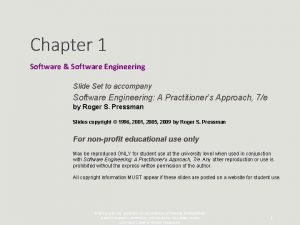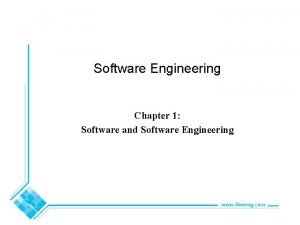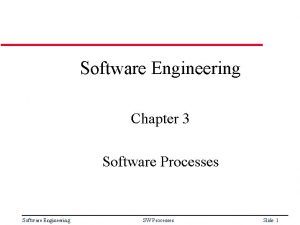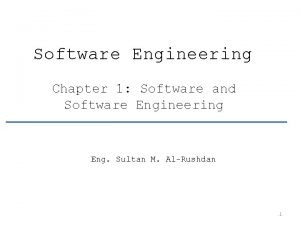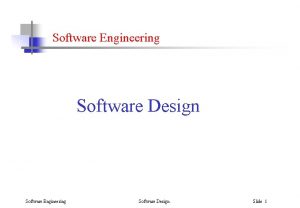Chapter 2 n Software Engineering Slide Set to



















- Slides: 19

Chapter 2 n Software Engineering Slide Set to accompany Software Engineering: A Practitioner’s Approach, 8/e by Roger S. Pressman and Bruce R. Maxim Slides copyright © 1996, 2001, 2005, 2009, 2014 by Roger S. Pressman For non-profit educational use only May be reproduced ONLY for student use at the university level when used in conjunction with Software Engineering: A Practitioner's Approach, 8/e. Any other reproduction or use is prohibited without the express written permission of the author. All copyright information MUST appear if these slides are posted on a website for student use. These slides are designed to accompany Software Engineering: A Practitioner’s Approach, 8/e (Mc. Graw-Hill 2014). Slides copyright 2014 by Roger Pressman. 1

Software Engineering n Some realities: n n n a concerted effort should be made to understand the problem before a software solution is developed design becomes a pivotal activity software should exhibit high quality software should be maintainable The seminal definition: n [Software engineering is] the establishment and use of sound engineering principles in order to obtain economically software that is reliable and works efficiently on real machines. These slides are designed to accompany Software Engineering: A Practitioner’s Approach, 8/e (Mc. Graw-Hill 2014). Slides copyright 2014 by Roger Pressman. 2

Software Engineering n The IEEE definition: n n n Software Engineering: (1) The application of a systematic, disciplined, quantifiable approach to the development, operation, and maintenance of software; that is, the application of engineering to software. (2) The study of approaches as in (1). These slides are designed to accompany Software Engineering: A Practitioner’s Approach, 8/e (Mc. Graw-Hill 2014). Slides copyright 2014 by Roger Pressman. 3

A Layered Technology tools methods process model a “quality” focus Software Engineering These slides are designed to accompany Software Engineering: A Practitioner’s Approach, 8/e (Mc. Graw-Hill 2014). Slides copyright 2014 by Roger Pressman. 4

A Process Framework Process framework Framework activities work tasks work products milestones & deliverables QA checkpoints Umbrella Activities These slides are designed to accompany Software Engineering: A Practitioner’s Approach, 8/e (Mc. Graw-Hill 2014). Slides copyright 2014 by Roger Pressman. 5

Framework Activities n n n Communication Planning Modeling n n n Construction n Analysis of requirements Design Code generation Testing Deployment These slides are designed to accompany Software Engineering: A Practitioner’s Approach, 8/e (Mc. Graw-Hill 2014). Slides copyright 2014 by Roger Pressman. 6

Umbrella Activities n n n n Software project tracking and control Risk management Software quality assurance Technical reviews Measurement Software configuration management Reusability management Work product preparation and production These slides are designed to accompany Software Engineering: A Practitioner’s Approach, 8/e (Mc. Graw-Hill 2014). Slides copyright 2014 by Roger Pressman. 7

Adapting a Process Model n n n n n the overall flow of activities, actions, and tasks and the interdependencies among them the degree to which actions and tasks are defined within each framework activity the degree to which work products are identified and required the manner which quality assurance activities are applied the manner in which project tracking and control activities are applied the overall degree of detail and rigor with which the process is described the degree to which the customer and other stakeholders are involved with the project the level of autonomy given to the software team the degree to which team organization and roles are prescribed These slides are designed to accompany Software Engineering: A Practitioner’s Approach, 8/e (Mc. Graw-Hill 2014). Slides copyright 2014 by Roger Pressman. 8

The Essence of Practice n Polya suggests: 1. Understand the problem (communication and analysis). 2. Plan a solution (modeling and software design). 3. Carry out the plan (code generation). 4. Examine the result for accuracy (testing and quality assurance). These slides are designed to accompany Software Engineering: A Practitioner’s Approach, 8/e (Mc. Graw-Hill 2014). Slides copyright 2014 by Roger Pressman. 9

Understand the Problem n n Who has a stake in the solution to the problem? That is, who are the stakeholders? What are the unknowns? What data, functions, and features are required to properly solve the problem? Can the problem be compartmentalized? Is it possible to represent smaller problems that may be easier to understand? Can the problem be represented graphically? Can an analysis model be created? These slides are designed to accompany Software Engineering: A Practitioner’s Approach, 8/e (Mc. Graw-Hill 2014). Slides copyright 2014 by Roger Pressman. 10

Plan the Solution n n Have you seen similar problems before? Are there patterns that are recognizable in a potential solution? Is there existing software that implements the data, functions, and features that are required? Has a similar problem been solved? If so, are elements of the solution reusable? Can subproblems be defined? If so, are solutions readily apparent for the subproblems? Can you represent a solution in a manner that leads to effective implementation? Can a design model be created? These slides are designed to accompany Software Engineering: A Practitioner’s Approach, 8/e (Mc. Graw-Hill 2014). Slides copyright 2014 by Roger Pressman. 11

Carry Out the Plan n n Does the solution conform to the plan? Is source code traceable to the design model? Is each component part of the solution provably correct? Has the design and code been reviewed, or better, have correctness proofs been applied to algorithm? These slides are designed to accompany Software Engineering: A Practitioner’s Approach, 8/e (Mc. Graw-Hill 2014). Slides copyright 2014 by Roger Pressman. 12

Examine the Result n n Is it possible to test each component part of the solution? Has a reasonable testing strategy been implemented? Does the solution produce results that conform to the data, functions, and features that are required? Has the software been validated against all stakeholder requirements? These slides are designed to accompany Software Engineering: A Practitioner’s Approach, 8/e (Mc. Graw-Hill 2014). Slides copyright 2014 by Roger Pressman. 13

Hooker’s General Principles n n n n 1: The Reason It All Exists 2: KISS (Keep It Simple, Stupid!) 3: Maintain the Vision 4: What You Produce, Others Will Consume 5: Be Open to the Future 6: Plan Ahead for Reuse 7: Think! These slides are designed to accompany Software Engineering: A Practitioner’s Approach, 8/e (Mc. Graw-Hill 2014). Slides copyright 2014 by Roger Pressman. 14

Software Myths Affect managers, customers (and other non-technical stakeholders) and practitioners n Are believable because they often have elements of truth, but … n Invariably lead to bad decisions, therefore … n Insist on reality as you navigate your way through software engineering n These slides are designed to accompany Software Engineering: A Practitioner’s Approach, 8/e (Mc. Graw-Hill 2014). Slides copyright 2014 by Roger Pressman. 15

Management Myths n n n We already have a book that’s full of standards and procedures for building software. Won’t that provide my people with everything they need to know? If we get behind schedule, we can add more programmers and catch up (sometimes called the “Mongolian horde" concept) If I decide to outsource the software project to a third party, I can just relax and let that firm build it. ,

Customer Myths n n A general statement of objectives is sufficient to begin writing programs – we can fill in the details later. Software requirements continually change, but change can be easily accommodated because software is flexible.

Practitioner’s Myths n n Once we write the program and get it to work, our job is done. Until I get the program “running” I have no way of assessing its quality. The only deliverable work product for a successful project is the working program. Software engineering will make us creative voluminous and unnecessary documentation and will iteratively slow us down.

Q&A
 How to heel toe dance
How to heel toe dance Total set awareness set consideration set
Total set awareness set consideration set Training set validation set test set
Training set validation set test set Computer based system engineering
Computer based system engineering Forward engineering in software engineering
Forward engineering in software engineering Software maintenance process models ppt
Software maintenance process models ppt Frank maurer
Frank maurer What is software metrics in software engineering
What is software metrics in software engineering Software engineering crisis
Software engineering crisis Examples of product metrics
Examples of product metrics Real time software design in software engineering
Real time software design in software engineering Software design fundamentals in software engineering
Software design fundamentals in software engineering How to do slide and divide
How to do slide and divide Bounded set vs centered set
Bounded set vs centered set Fuzzy logic
Fuzzy logic Crisp set vs fuzzy set
Crisp set vs fuzzy set Crisp set vs fuzzy set
Crisp set vs fuzzy set What is the overlap of data set 1 and data set 2?
What is the overlap of data set 1 and data set 2? The function from set a to set b is
The function from set a to set b is Software engineering chapter 2
Software engineering chapter 2



















